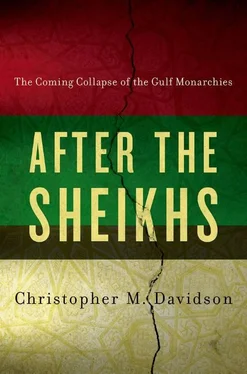Kuwait’s history is somewhat different, as religion has played a less prominent role while — as a much smaller territory — relations with foreign powers have been more significant. Nevertheless, as with the Al-Saud dynasty, Kuwait’s ruling Al-Sabah family is also very much a product of centuries-old tribal struggles. As a branch of the huge Bani Utub tribal federation, the Al-Sabah had migrated north out of the Arabian interior in the late seventeenth century along with another prominent Bani Utub family, the Al-Khalifa. Both settled in the fishing and trading post of Kuwait, before the latter left for the settlement of Zubarah on the Qatari Peninusla in 1766. [63] 7. Roberts, David, ‘Kuwait’ in Davidson, Christopher M. (ed.), Power and Politics in the Persian Gulf Monarchies (London: Hurst, 2011), p. 89.
By this stage the Al-Sabah were in firm control of Kuwait, and their ruler — Abdullah Al-Sabah — spent the next four decades consolidating his family’s supremacy over the sheikhdom’s political and economic affairs. In the nineteenth century Kuwait remained autonomous of the Saudi-Wahhabi alliance, mostly due to the Al-Sabah receiving nominal protection from the Ottoman Empire.
Under the rule of Mubarak Al-Sabah, also known as ‘Mubarak the Great’, Kuwait nevertheless began to move much closer to Britain, eventually signing an agreement in 1899 which guaranteed the sheikhdom British protection in exchange for London’s control over its foreign affairs. In part this new relationship was due to Mubarak’s troubled succession in 1886: having replaced his assassinated elder brother [64] 8. Muhammad Al-Sabah.
he needed to counter the Ottoman links still maintained by his predecessor’s supporters. [65] 9. For a full discussion see Crystal, Jill, Oil and Politics in the Gulf: Rulers and Merchants in Kuwait and Qatar (New York: Cambridge University Press, 1995), chapter 1.
On a more macro level the switch in protection was also due to the decline of the Ottoman Empire, and was intended to improve access to British-Indian markets, especially in pearls, which at that time were Kuwait’s most lucrative export. In any case, Ottoman influence greatly decreased, although subsequent Al-Sabah rulers briefly tried to use relations with Istanbul during the First World War as leverage over Britain. [66] 10. Roberts (2011), p. 90.
In the early 1920s, relations with Britain deepened further following a Saudi-Wahhabi attack on Kuwait’s Jahra fort [67] 11. This took place in 1921.
which resulted in the deployment of British gunboats and the crafting of a British-backed border agreement between the Al-Sabah, the Al-Saud, and Britain’s mandated territory of Iraq. [68] 12. Signed in 1921, the Uqair agreement required Kuwait to give up much of its territory to the Al-Saud, while also defining its borders with the British-mandated territory of Iraq. See Lauterpacht, E., Greenwood, C. J., Weller, Marc, ‘The Determination of Boundaries between Iraq, Kuwait and Saudi Arabia (Najd)’ in The Kuwait Crisis: Basic Documents (Cambridge: Cambridge University Press, 1991), pp. 45–49.
Like Kuwait, the other small Gulf monarchies had entered into similar protection agreements with Britain, but in most cases they had done so much earlier. This was partly because of the more immediate threat and regular attacks they faced from the Saudi-Wahhabi alliance, and partly because the Ottoman Empire was less relevant to the various sheikhs of the lower Persian Gulf, with its agents making fewer visits there. But more important, at least from the British perspective, was that the British East India Company — which controlled the highly profitable maritime trade routes between Bombay and Basra — had begun complaining towards the end of the eighteenth century of disruptive ‘pirate attacks’ on their ships. While the authenticity of these complaints remains contested, with some historians contending that the Company was primarily interested in removing local trade rivals, [69] 13. See for example Davies, Charles E., The Blood Red Arab Flag: An Investigation into Qasimi Piracy, 1797–1820 (Exeter: Exeter University Press, 1997); Al-Qasimi, Sultan bin Muhammad, The Myth of Arab Piracy in the Gulf (London: Croom Helm, 1986).
Britain nevertheless responded to the Company’s concerns and mounted a series of naval and amphibious attacks in 1809 and 1819 on various ports in the lower Gulf. After the threat of piracy was removed Britain then began offering peace treaties or ‘truces’ to the several identifiable sheikhdoms in the area. In this way, their respective ruling families became recognised by Britain as the heads of ‘Trucial States’, having ceded control over their own foreign affairs and guaranteed no further pirate attacks in exchange for imperial protection. After several renewals the treaties were made permanent in 1853 under the Perpetual Maritime Truce: a durable and mutually beneficial arrangement that remained in place for more than a century.
By this stage, the ruling Al-Khalifa family of Bahrain was well established, having not only signed the British treaties but also eventually hosting Britain’s regional base — the ‘permanent residency’. As descendants of the same Bani Utub clan that had departed from Kuwait in the 1760s, in 1783 they had invaded Bahrain and defeated its Omani-origin ruler of the time. [70] 14. Nasser Al-Makhdur. The Al-Makhdur family also ruled over Bushire, on the Persian coastline. See Hopwood, Derek, The Arabian Peninsula (London: George Allen and Unwin, 1972), p. 40.
They and their allies then moved their homes from Zubarah to the Bahraini towns of Riffa and Muharraq. Although attacked by the Saudi-Wahhabi alliance at the turn of the century and briefly occupied by Oman in 1802, the Al-Khalifa soon consolidated their hold over the archipelago, with Abdullah bin Ahmed Al-Khalifa and Salman bin Ahmed Al-Khalifa emerging as joint rulers.
In many ways the ruling Al-Thani family of Qatar emerged from the shadow of the Al-Khalifa, with their ancestors having co-habited Zubarah and other parts of the peninsula under nominal Al-Khalifa control until 1867, when a Bahraini force attacked Doha, another Qatari settlement. Given that the attack was seaborne, it meant that the Al-Khalifa had broken the terms of their British peace treaty, prompting Britain to separate Qatar from the Al-Khalifa and offer formal recognition to Muhammad bin Thani, an influential tribal leader who had previously allied himself with the Saudi-Wahhabi movement. Within just four years, however, Muhammad’s son and successor, Jassim bin Muhammad Al-Thani, deemed Britain an unsuitable guarantor against renewed threats from Bahrain and moved into an alliance with the Ottomans — a relationship which continued until 1893 when Jassim refused to permit an Ottoman customs house in Qatar. In 1916, with no remaining Ottoman influence in his territories, Jassim’s son — Abdullah bin Jassim Al-Thani — finally signed Britain’s Perpetual Maritime Truce, thus bringing Qatar into the Trucial States.
The ruling Al-Qasimi family of Ra’s Al-Khaimah in many ways bore the brunt of the British attacks in 1809 and 1819. Remaining weakened, they had to cede control of their second town, Sharjah, to a distaff branch of the family in 1869, and between 1900 and 1921 even fell under Sharjah’s control. Nevertheless, both Ra’s al-Khaimah and Sharjahs’ rulers signed the British treaties, and both were recognised as ‘gun salute’ states, [71] 15. The rulers of Trucial States were all given gun salutes by the cannons of visiting British warships. The number of cannon blasts corresponded with Britain’s perception of a ruler’s relative power and influence in the region.
given their strategic position close to British-Indian shipping lanes. Rising in prominence throughout the nineteenth century, in part due to the declining fortunes of the Al-Qasimi, was the ruling Al-Nahyan family of Abu Dhabi. As the dominant clan of the large Bani Yas tribal grouping, the Al-Nahyan had moved from the interior to the island of Abu Dhabi in the late eighteenth century, and — given their relative innocence in the alleged attacks on British shipping — were especially well placed to benefit from British protection. Ruled between 1840 and 1909 by Zayed bin Khalifa Al-Nahyan or ‘Zayed the Great’, Abu Dhabi was able to fend off repeated Saudi-Wahhabi attacks which allowed the Al-Nahyan to consolidate their control over much of the coastline of the lower Gulf. However, much like Qatar’s secession from Bahrain, the Al-Nahyan were soon forced to relinquish control over their second town, the fast-growing fishing and pearling port of Dubai. In 1833, following a significant tribal dispute, Maktoum bin Butti, also of the Bani Yas, and several hundred tribesmen left Abu Dhabi, moving up the coast to settle in Dubai. Sidelining the Al-Nahyan governors [72] 16. During this period Dubai was governed by Muhammad bin Hazza Al-Nahyan and his uncle Zayed bin Saif Al-Nahyan.
and declaring Dubai to be an autonomous sheikhdom, they soon entered into Britain’s Perpetual Maritime Truce, thus helping protect the nascent Al-Maktoum dynasty from a number of Abu Dhabi and Sharjah-launched attacks. In the 1880s and 1890s, under Rashid bin Maktoum Al-Maktoum and then Maktoum bin Hasher Al-Maktoum, Dubai’s influence expanded greatly as it became an effective free port for the region, attracting large numbers of disgruntled merchant families from other sheikhdoms and even from towns on the Persian coastline. [73] 17. Davidson, Christopher M., Dubai: The Vulnerability of Success (London: Hurst, 2008), pp. 12–14.
Читать дальше












